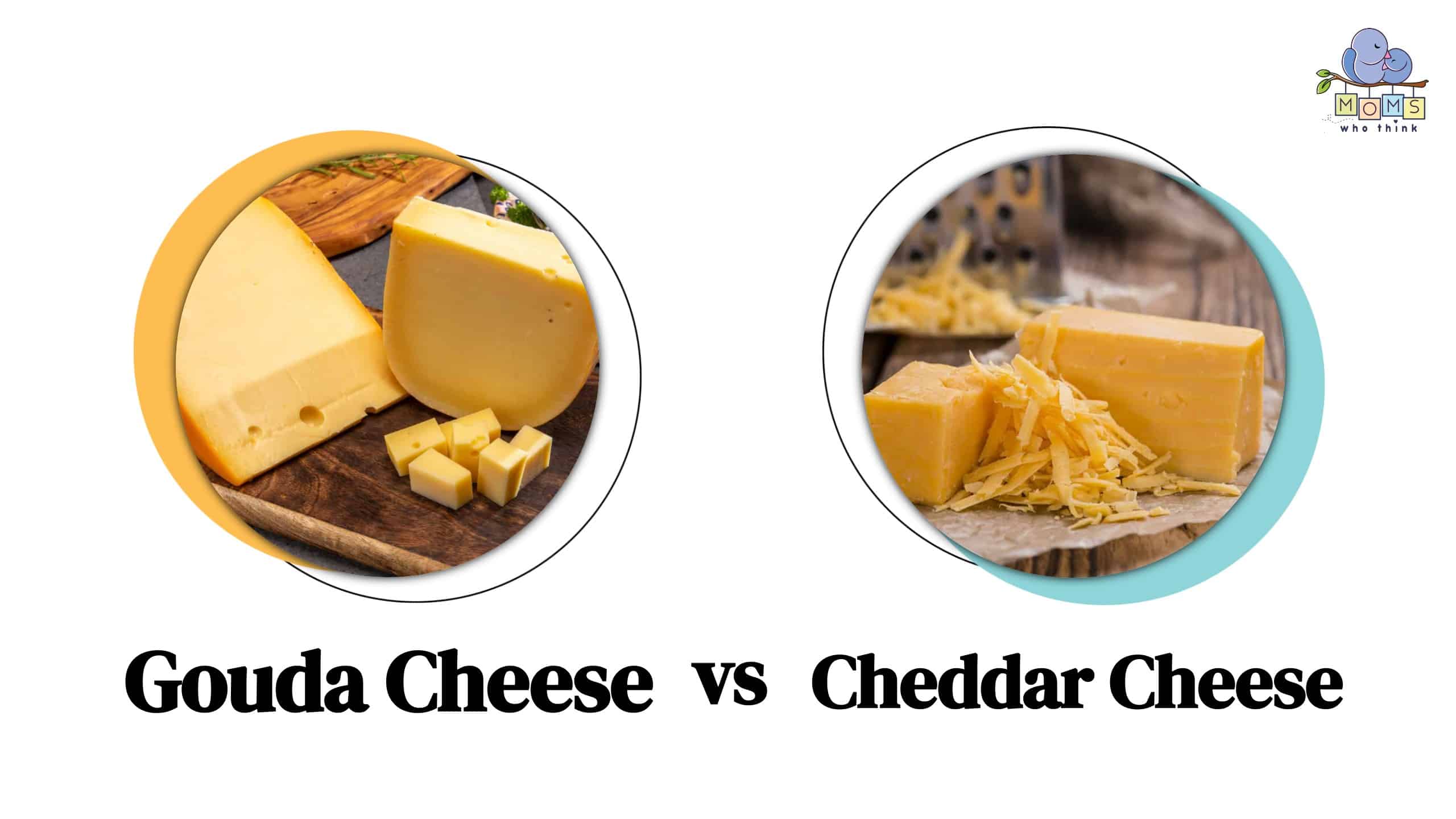Are you tired of the same old cheese options for your family's meals? It's time to mix things up and explore the world of Gouda and cheddar! These two cheeses may seem similar, but they are both unique in their own way.
Let's break down the flavors, textures, and uses of each cheese, so you can make an informed decision the next time you're at the grocery store. Get ready to discover new ways to incorporate these delicious cheeses into your cooking and elevate your meals to the next level.
Gouda Cheese vs. Cheddar Cheese: What Is the Difference?
While Gouda and cheddar are both semi-hard cheeses, they have several differences that set them apart. For instance, Gouda originated from the Netherlands and has a rich, buttery, and slightly sweet taste. Cheddar, on the other hand, originated from England and has a sharper, tangier taste than Gouda.
Both cheeses differ in texture as well, with cheddar typically being harder. Both kinds of cheese are often used in sandwiches or eaten alone. Cheddar is often used in mac and cheese recipes while gouda melts well and is particularly popular in side dishes.
Let's take a closer look at each cheese and what makes them different.
Gouda Cheese vs. Cheddar Cheese Nutrition: What Has More Calories?
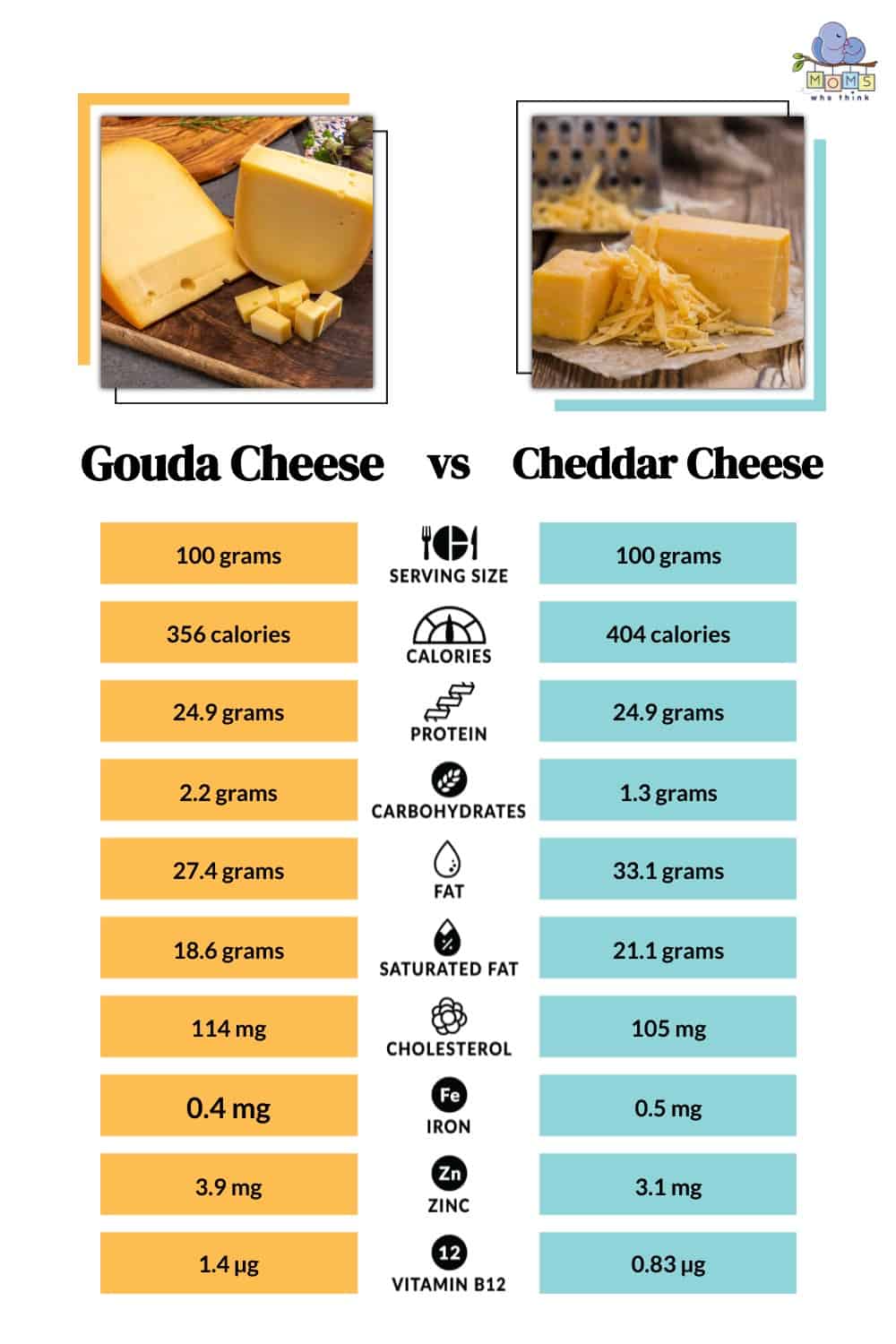
©
Both gouda cheese and cheddar cheese are high in fat and protein calories and low in carbohydrates. In general, an ounce of gouda has around 100 calories while cheddar cheese tends to be around 10 to 15% higher in calories per ounce.
However, be aware that different brands of both cheeses can yield different nutritional values. Both types of cheese are excellent sources of calcium, with around 20% of your suggested daily value in just a single ounce of cheese.
What is Gouda Cheese?
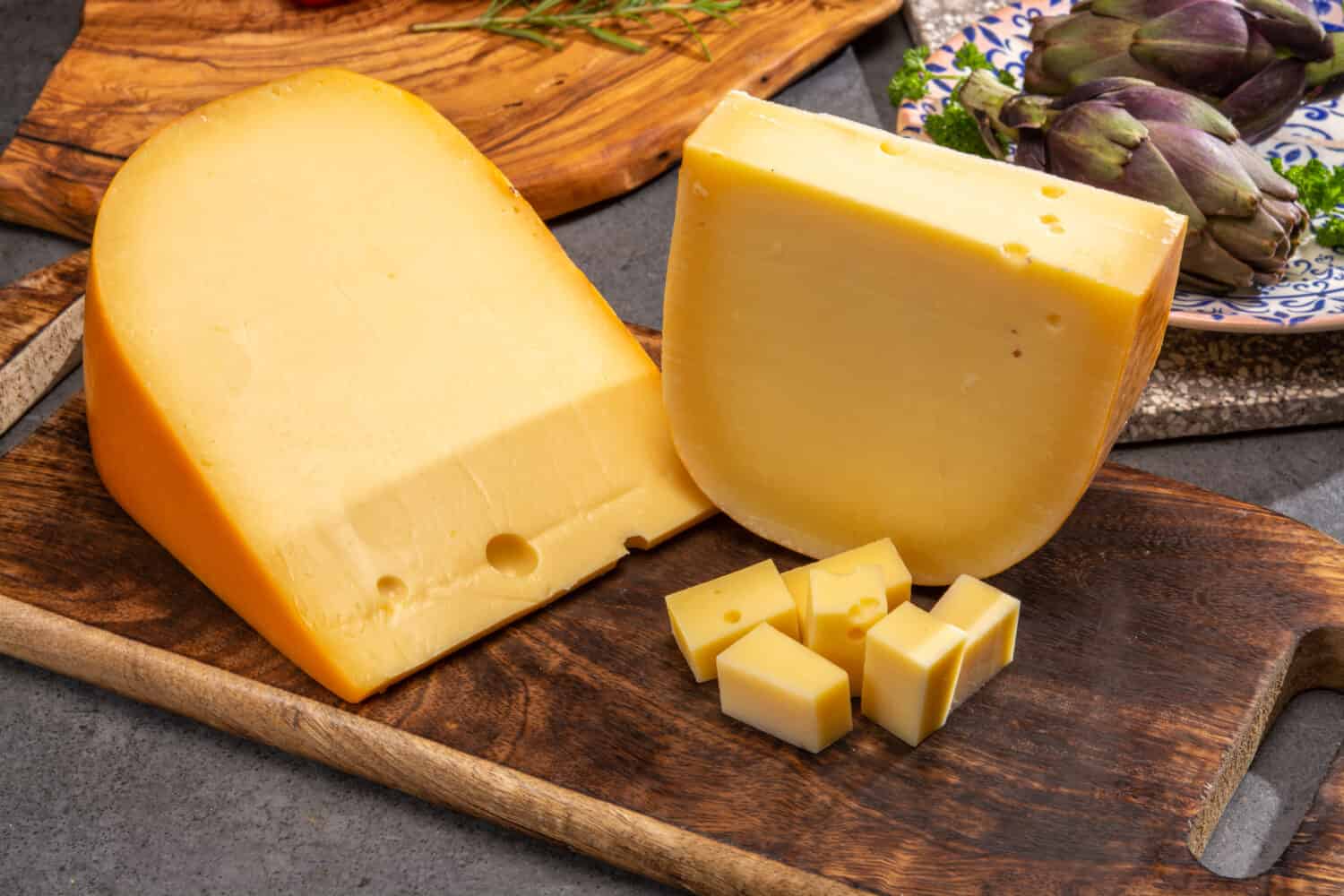
©barmalini/Shutterstock.com
As mentioned, Gouda is a semi-hard cheese that originated in the Netherlands. It ranges in flavor depending on its age but is often a smooth, rich, and slightly nutty and sweet cheese.
Origin
Gouda comes from a town with the same name, Gouda, in the South Holland region of the Netherlands. This style of cheese is thought to have been created in the 1500s but may date back as far as the 12th century. The cheese is commonly made from pasteurized or unpasteurized cow's milk, but can also contain sheep's milk or goat's milk.
While traditional Dutch Gouda is still manufactured and distributed today, other countries have begun making and selling their own version of Gouda. According to cheese.com, authentic Dutch Gouda is often called, boerenkaas which is cheese created from unpasteurized cow's milk from cows who grazed on the natural pastures of the Netherlands.
Flavor
The taste of Gouda can vary depending on its age. Young Gouda has a mild, buttery flavor with a slightly sweet taste. As it ages, it becomes nuttier and sharper, with a deeper flavor. In general, however, Gouda does not have as strong of a flavor as cheddar.
Texture and Appearance
Because Gouda is a semi-hard cheese, it has a firm but creamy texture, making it perfect for slicing and melting. Most forms of Gouda also have a visible and inedible orange or red wax rind. Depending on age, the cheese can also range from a pale off-white color to deep orange. Younger Gouda varieties tend to be lighter in color with aged varieties becoming darker and a little more orange.
How Gouda Is Made
Like most cheeses, Gouda is made from heating milk (most often cow's milk, but, as mentioned, sometimes sheep's and goat's milk is added) and then combining it with rennet. Rennet causes the milk to curdle and the curds are collected and drained from the liquid (whey). The curds are then pressed into a mold to remove as much moisture as possible, giving Gouda its drier consistency.
What sets Gouda apart from some other cheeses is that once it's molded and formed, it's then soaked in brine. The brine gives the cheese its signature flavor and aids in the aging process. Once Gouda is soaked in brine, it's left to age anywhere from a few weeks up to a few years, depending on the desired taste and texture.
Popular Uses
Gouda cheese can be used in many ways in the kitchen. Its versatility makes it great on anything from snacking to melting on burgers or sandwiches. Gouda is also popular in salads and can be shredded and used in pasta dishes or on top of pizza. Young Gouda is perfect for cheeseboards, while aged Gouda can be grated over soups or used in fondue.
What is Cheddar Cheese?
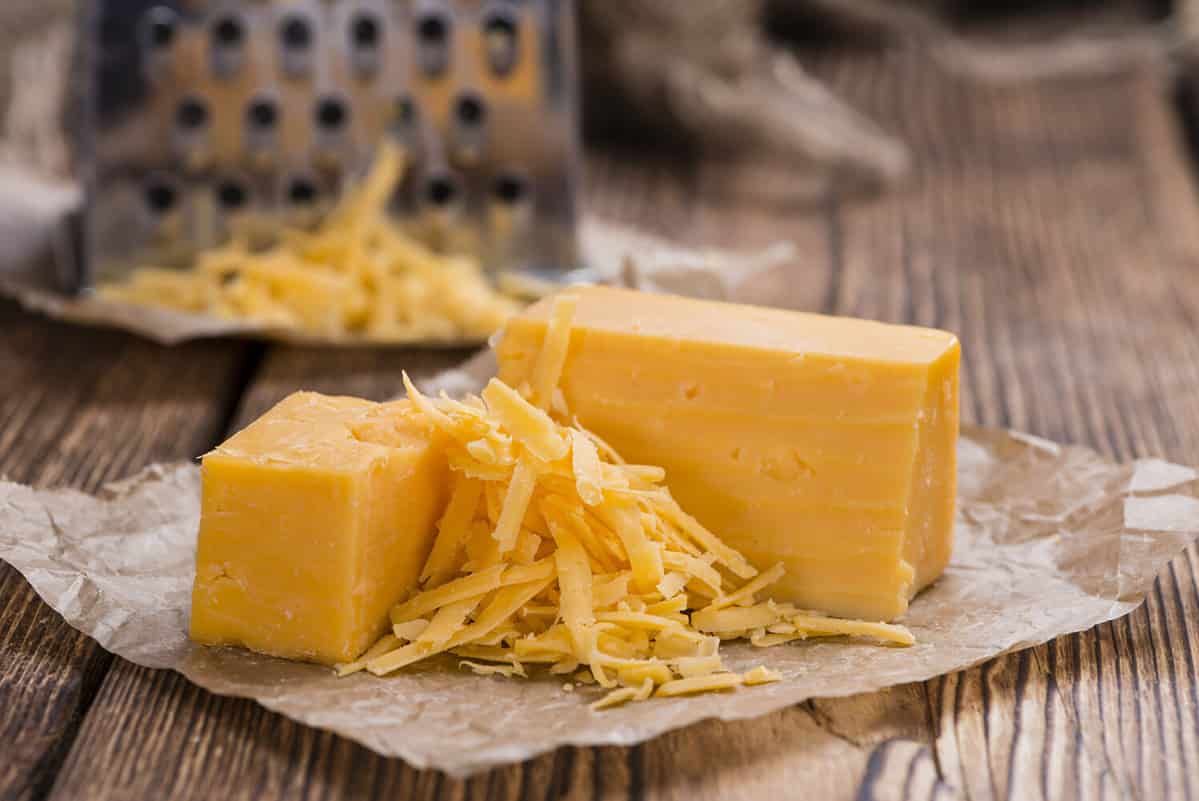
©HandmadePictures/Shutterstock.com
While cheddar is also a semi-hard cheese that's made from cow's milk, it originated in England, not the Netherlands like Gouda. Cheddar also has a slightly crumbly texture and sharper flavor than Gouda, though it's similar in that cheddar also gets sharper in flavor as it ages.
Origin
Cheddar cheese originates from the town of Cheddar in Somerset, England dating back as far as the 12th century. As the production process was enhanced over time, techniques were developed for controlling the temperature and acidity of the milk to produce consistent and high-quality cheese. Soon after, cheddar cheese was exported to other countries.
Cheddar cheese is now one of the most popular cheeses across the world. Large cheese factories have been created to meet the growing demand and numerous varieties of this sharp, tangy cheese.
Flavor
As mentioned, cheddar cheese has a distinct, tangy flavor that becomes sharper and more complex as it ages. Fresher forms of cheddar cheese are milder, with a slight buttery flavor while aged versions become more distinct in flavoring.
Texture and Appearance
Cheddar cheese can range in color from pale yellow to off-white, though some manufacturers add coloring to give it its signature golden hue. Unlike Gouda which is firm and great for melting, cheddar is a somewhat crumbly cheese.
How Cheddar Cheese Is Made
Cheddar cheese begins its production process the same way most cheeses do: By adding rennet to milk in order to create curdles. The curds are then cut into pieces, pressed, and continually flipped to remove as much liquid (or whey) as possible. What's left is dense, dry, and somewhat crumbly cheddar cheese. This process is unique enough that it's been coined, cheddaring.
Mild varieties are only aged two to three months. Extra sharp versions are left to age from one to five years.
Popular Uses
Like Gouda, cheddar cheese is extremely versatile. While it can be used on sandwiches, burgers, macaroni and cheese, and soups, it's also popular for snacking and pairs well with fruits, nuts, and crackers.
It's also important to note that the pre-shredded forms of cheddar cheese typically found in your local grocery store include cornstarch to prevent clumping. If you're looking for a stronger flavor and a more creamy melted version, try shredding a block of cheddar yourself.
Can You Substitute Gouda for Cheddar?
Yes, Gouda and cheddar can be substituted for each other in many recipes without any issues. However, it's important to remember that each cheese has its own unique flavor and texture that could alter your dish.
Gouda typically has a milder, sweeter flavor than cheddar, with a creamier texture. Cheddar has a sharper, tangier flavor with a firm, dry, and crumbly texture. If you're substituting Gouda for cheddar, you may want to use a slightly larger amount to achieve a similar level of flavor. On the other hand, if you're substituting cheddar for Gouda, you may want to use less cheese to avoid overwhelming the dish with a strong flavor.
You will also want to consider the ages of these cheeses. As both age, they develop a stronger flavor, so you may not want to substitute an aged cheddar for a young Gouda.
Best Substitutes for Gouda and Cheddar Cheese
In a pinch or looking to switch things up in the kitchen? Here are a few other substitutes for Gouda and cheddar that work well:
Colby or Monterey Jack Cheese
Both of these cheeses are softer and milder in flavor but have a similar texture to cheddar which makes them easy replacements in many dishes.
Parmesan Cheese
While parmesan is a hard, salty cheese, its sharp and nutty flavor makes it a great replacement for recipes like pizza or pasta.
Edam
Edam cheese is a semi-hard cheese that is similar in flavor and texture to Gouda, but milder. It works well as a replacement in sandwiches and as a snack cheese.
Havarti
Havarti cheese is a soft, buttery cheese, similar to Gouda. It also has a slightly tangy flavor and, like Edam, is a great substitute for snacks and sandwiches.
Provolone Cheese
This mild, slightly sweet cheese has a firmer texture than Gouda, but still works well as a replacement in Italian dishes like pasta, pizza, and sandwiches.
Gouda Cheese Recipes
Print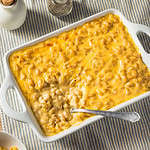
Mac and Cheese Bake
- Yield: Makes 2 entrees, each entree serves 4 1x
Ingredients
⅓ cup dry whole-wheat bread crumbs
2 tablespoons olive oil
1 package (16 ounce) frozen spinach
3½ cups milk, divided
6 tablespoons all-purpose flour
2 cups shredded extra-sharp Cheddar cheese
2 cups shredded Gouda cheese
2 cups low-fat cottage cheese
½ teaspoon nutmeg
Salt and black pepper to taste
1 pound whole-wheat penne
½ teaspoon nutmeg
Supplies needed:
Two – 8×8 foil baking dish
Instructions
1. Generously spray both baking dishes with cooking spray. Bring a large pot of salted water to a boil.
2. In a small bowl, toss together bread crumbs and olive oil.
3. Cook spinach according to package directions. Drain and refresh under cold water. Press out excess moisture. Set aside.
4. In a large saucepan over medium-high heat, bring 3 cups milk to a low simmer.
5. In a small bowl, whisk together remaining milk and flour until smooth. Whisk flour mixture into hot milk mixture, whisking constantly, until sauce thickens.
6. Remove saucepan from heat and stir in Cheddar and Gouda, stirring until cheese melts. Stir in cottage cheese and season with nutmeg, salt, and pepper.
7. Cook pasta in the pot of boiling water for 3 minutes less than package directions, about 6 minutes. Drain in colander and add to cheese sauce, stirring to combine.
8. Spread one-quarter of the pasta mixture in the prepared baking dishes. Spoon spinach over top. Top with remaining pasta and sprinkle with bread crumbs.
9. To serve now, preheat the oven to 400°F. Bake for 20-25 minutes or until bubbly.
Nutrition
- Serving Size: Per serving
- Calories: 417
- Sodium: 181mg
- Fat: 21g
- Carbohydrates: 31g
- Fiber: 7g
- Protein: 25g
- Cholesterol: 72mg
Cheddar Cheese Recipes
- Brown Sugar Glazed Cheddar Meatloaf
- Pulled Smokey Chicken Sandwiches with Cheddar
- Mexican Pizza with Refried Beans and Cheddar
Final Thoughts
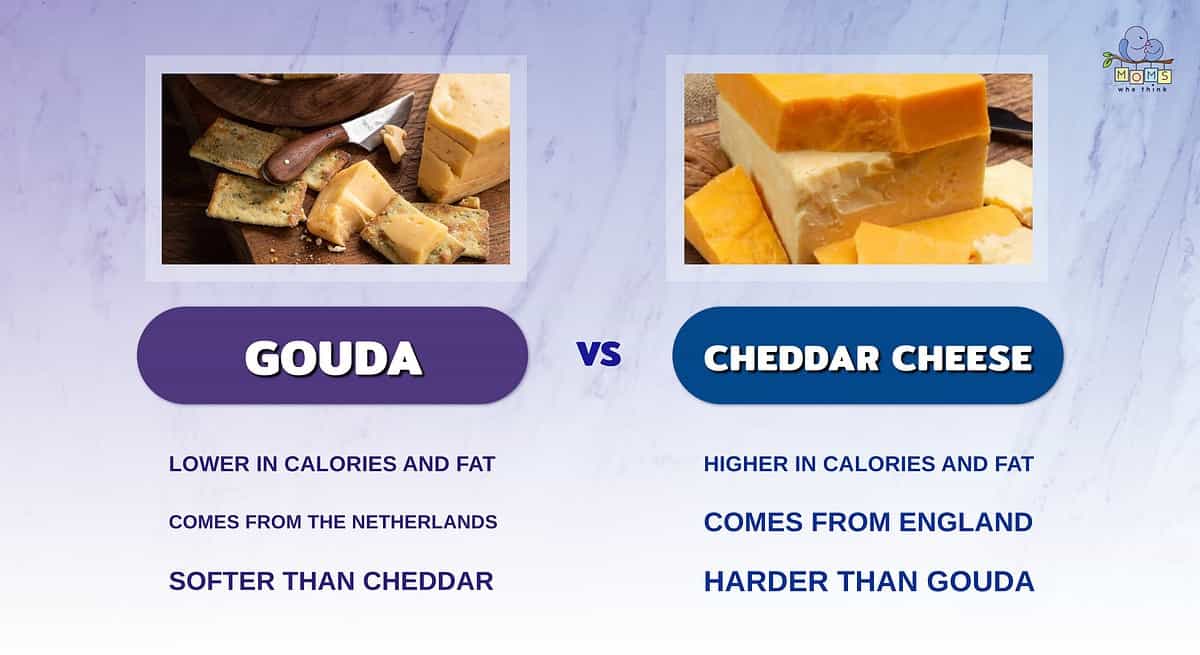
- Gouda is lower in calories and fat compared to cheddar cheese, but both pack on the calories and fat.
- Cheddar cheese hails from England, while gouda comes from the Netherlands! Both of these cheeses are important parts of their respective cultures.
- Gouda is softer than cheddar; this may make it a preferred cheese for some.
In conclusion, Gouda and cheddar are flavorful cheeses that can take your recipes to the next level. By taking a closer look at these two cheeses, you can open up a world of new flavors, textures, and cooking possibilities. Whether you're looking for a creamy, nutty cheese, or a sharp, tangy flavor, Gouda and cheddar have got you covered. So the next time you're at the grocery store, don't be afraid to try one of these cheeses and add some excitement to your family's next meal.
